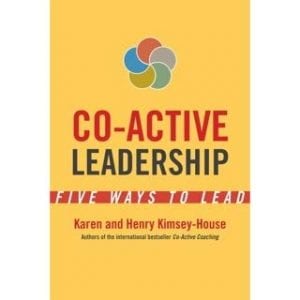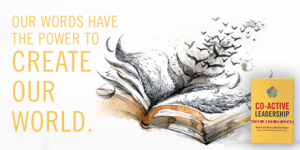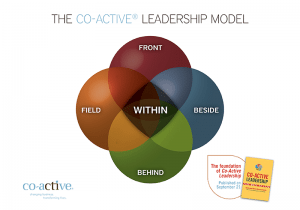 Have you ever been preparing for a meeting, be it with colleagues or students where you think “I need a different approach” or “How do I best work with this person to move forward in a generative way?”. This is a book for those looking to adopt a framework that moves beyond one-dimensional approaches to leadership and it is for those looking to develop, refine or retool skills and approaches for working with others.
Have you ever been preparing for a meeting, be it with colleagues or students where you think “I need a different approach” or “How do I best work with this person to move forward in a generative way?”. This is a book for those looking to adopt a framework that moves beyond one-dimensional approaches to leadership and it is for those looking to develop, refine or retool skills and approaches for working with others.
What is Co-Active Leadership?
The authors, Karen and Henry Kimsey-House, begin their book stating “Co-Active leadership is based on a few simple and somewhat radical themes, the first being that leadership needs to be approached in a multidimensional way to include a range of styles and approaches.” (pg. ix) I couldn’t agree more. We need to be more than just one way of leading and as a leader, one should strive to be known as having more than one dominant approach. This requires a framework, and for me, this framework of 5 dimensions really help me understand WHO I can show up as for others, and HOW to do so effectively.
The 5 Dimensions of Leadership:
In this model, there are five different dimensions of leadership that are all interconnected, and while we have the capacity for each, and the ability to develop our skills in each, we lean into different dimensions depending on the needs of ourselves, our organization and those that we are leading.
Leader Within: This is where the book begins, and rightly so. This is the dimension that grounds leaders in their world. It is about knowing our  purpose and our values. It requires compassion, for ourselves and others, and courage to stand up for what we believe, against those that are not acting with integrity, and to build momentum behind one’s vision. This image to the right summarizes the Leader Within very effectively. Leaders are responsible for the world they inhabit, for the world they lead, and for the world that they create.
purpose and our values. It requires compassion, for ourselves and others, and courage to stand up for what we believe, against those that are not acting with integrity, and to build momentum behind one’s vision. This image to the right summarizes the Leader Within very effectively. Leaders are responsible for the world they inhabit, for the world they lead, and for the world that they create.
Leader In Front: This is the natural image that comes to mind when thinking of leader – or is it? Karen and Henry Kimsey-House do an excellent job unpacking what an effective Leader in Front can be. Leaders in Front lead with vision and connection: if there is too much vision moving forward a leader will lose that connection to bring people along; conversely, if there is too much connection the vision and progress will get fuzzy and lose direction. An effective Leader in Front, “…stand[s] firmly for our vision in a way that nourishes everyone in the face of forces way beyond our control.”
Leaders in Front do this by having courageous conversations that make challenges (of culture, or logistics, or tradition, etc…) transparent and viewed as opportunities. They embrace ambiguity and look for opportunities to move from Leader in Front to Leader from Behind.
Leader Behind: This is one of my favourite dimensions because it emphasizes the need for inclusive and dynamic followership. Leaders Behind work with generosity and gratitude for others. While a Leader in Front charts the vision and works to the future, Leaders Behind work in present and focus on the needs of the moment: they anticipate challenges and work to allow the group to view these challenges as opportunities. They also are the ones who look to support and appreciate others. They do this by drawing upon their cultural knowledge and their ability to listen to others deeply: listening beyond the words and into the emotions.
This is my favourite one because it has been so difficult to articulate for me. This leadership stance is about knowing that you matter, it’s about knowing that you have responsibility and value to the organization, project, what have you. Now that I have this stance articulated, I can’t wait to use the language to help others position themselves in the organization.
Leader Beside: Partnership: 100% given by two or more people to the vision and the carrying out of that vision. I can’t help but think of @jmedved when I read this leadership stance. “…both parties leaning in 100 percent and each very sensitive to the direction of the other…both leaders balance 100 percent commitment with complete humility, being willing to take the lead or follow in each moment…it is impossible to tell who is leading and who is following because each one owns the whole thing at the same time.” (pg. 60)
This is about trust, and it is so very relational. Leaders Beside have a grounding in “WHY” first that allows them to have disagreements, shifts and navigate change together. “By supporting the best in each other, Co-Active Leaders Beside hold each other accountable for integrity and also for the vision and direction of where they are headed together.” (pg. 61)
This is where I strive to get to with others that I work with. Now that I know how to articulate this leadership stance, and the skills it calls upon (trust building, open communication, honesty and humility), I am excited to work in this dimension.
Leader in the Field: I loved reading about this dimension because it is something we can all relate to, but rarely acknowledge or value. Leaders in the Field

are in touch with their intuition and instinct. They slow down at critical times to listen to that intuition. This is best captured by the concept of responding and not just reacting. They tune into other fields to think outside the box and even think differently of how to approach projects, challenges and strategy. The authors adeptly quote Einstein, saying leaders in the field are attuned to the fact thatwe “…can’t solve problems by using the same kind of thinking we used when we created them.” (pg. 77).
The authors give an anecdote of an executive who builds in a 5 minute thinking break in all of her meetings so that others can deeply connect with the content of the meeting, but also the larger picture of what is happening in the moment and whether or not the meeting is as generative as it could be. Do we do this enough? Probably not.
Reflection Point:
I enjoyed this book the most when I used it as a reflective tool. At the end of each chapter I did an inventory or what I thought the skills and mindsets were that I was actively doing, what my areas of growth were, and then what questions I had about the chapter itself or how I can use this leadership stance to improve my practice. I recommend this approach because it opened up my eyes to new ideas to stubborn challenges 🙂
